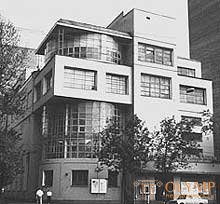
 Direction in Russian (USSR) art of the 1920s. (in architecture, design, and theatrical-decorative art, poster, book art, artistic design, design). Proponents of constructivism, having put forward the task of “designing” the environment, actively directing life processes, sought to comprehend the formative possibilities of technology, its logical, expedient designs, as well as the aesthetic possibilities of materials such as metal, glass, and wood.
Direction in Russian (USSR) art of the 1920s. (in architecture, design, and theatrical-decorative art, poster, book art, artistic design, design). Proponents of constructivism, having put forward the task of “designing” the environment, actively directing life processes, sought to comprehend the formative possibilities of technology, its logical, expedient designs, as well as the aesthetic possibilities of materials such as metal, glass, and wood.  Constructivists strove with ostentatious luxury to oppose simplicity and underlined utilitarianism of new objective forms, in which they saw the reification of democracy and new relations between people. In architecture, the principles of constructivism were formulated in theoretical speeches by A. A. Vesnin and M. Ya. Ginzburg. The spring project of the Palace of Labor for Moscow (1923) with its clear, rational plan and the constructive basis of the building (iron-concrete frame) revealed in appearance. In 1924, the creative organization of constructivists — OCA — was created, whose representatives developed the so-called functional design method based on a scientific analysis of the functioning of buildings, structures, and town-planning complexes.
Constructivists strove with ostentatious luxury to oppose simplicity and underlined utilitarianism of new objective forms, in which they saw the reification of democracy and new relations between people. In architecture, the principles of constructivism were formulated in theoretical speeches by A. A. Vesnin and M. Ya. Ginzburg. The spring project of the Palace of Labor for Moscow (1923) with its clear, rational plan and the constructive basis of the building (iron-concrete frame) revealed in appearance. In 1924, the creative organization of constructivists — OCA — was created, whose representatives developed the so-called functional design method based on a scientific analysis of the functioning of buildings, structures, and town-planning complexes. 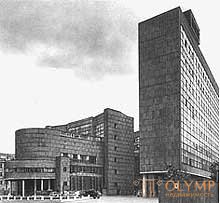
Along with other groups of Soviet architects, constructivists (the Vesnin brothers, Ginzburg, I. A. Golosov, I. I. Leonidov, A. S. Nikolsky, M. O. Barsch, V. N. Vladimirov, and others) searched for new principles planning of populated areas, put forward projects for the reorganization of life, developed new types of public buildings (Palaces of Labor, House of Councils, working clubs, factories, kitchens, etc.). 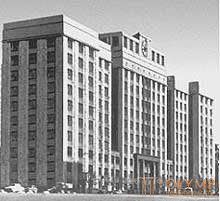 At the same time, in their theoretical and practical activities, the constructivists made a number of mistakes (attitude to an apartment as a "material form", schematism in the organization of life in some projects of communal houses, underestimation of natural and climatic conditions, underestimation of the role of large cities under the influence of desurbanism ideas).
At the same time, in their theoretical and practical activities, the constructivists made a number of mistakes (attitude to an apartment as a "material form", schematism in the organization of life in some projects of communal houses, underestimation of natural and climatic conditions, underestimation of the role of large cities under the influence of desurbanism ideas). 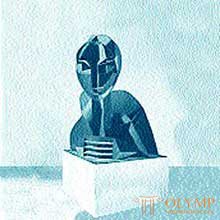
The aesthetics of constructivism in many respects contributed to the formation of modern artistic design. On the basis of the constructivist developments (A. M. Rodchenko, A. M. Ghana, and others), convenient to use and mass-produced new types of dishes, fittings, and furniture were created; artists developed drawings for fabrics (V. F. Stepanova, L. S. Popova) and practical models of working clothes (Stepanova, V. E. Tatlin). Constructivism played a prominent role in the development of poster graphics (photomontages of the Stenberg brothers, G. G. Klutsis, Rodchenko) and the design of the book (using expressive font possibilities and other typesetting elements in the works of Ghana, L. M. Lisitsky and others). 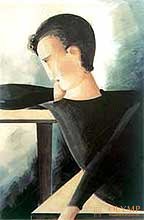 In the theater, the traditional constructivist scenery was replaced by subordinate tasks of stage action with “machine tools” for the work of actors (works by Popova, A. A. Vesnina, and others on the performances of V. E. Meyerhold, A. Ya. Tairov).
In the theater, the traditional constructivist scenery was replaced by subordinate tasks of stage action with “machine tools” for the work of actors (works by Popova, A. A. Vesnina, and others on the performances of V. E. Meyerhold, A. Ya. Tairov).
Some ideas of constructivism were embodied in Western European (V. Baumeister, O. Schlemmer and others) visual art. In relation to foreign art, the term "constructivism" is largely conditional: in architecture, it denotes a flow within functionalism that sought to emphasize the expression of modern constructions, in painting and sculpture it is one of the avant-garde styles that used some formal searches for early constructivism (sculptors I. Gabo, A Pevzner).
Что бы оставить комментарий войдите
Комментарии (0)